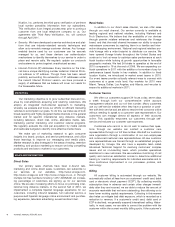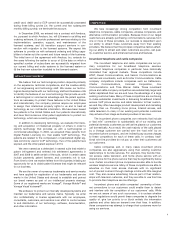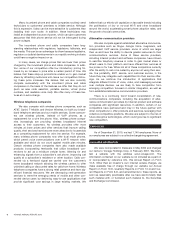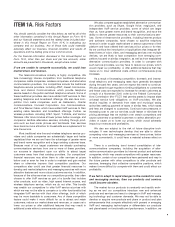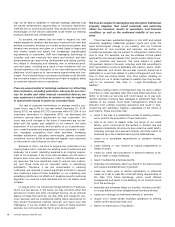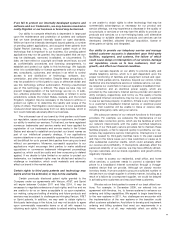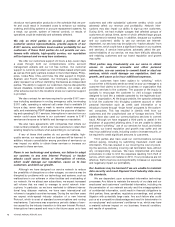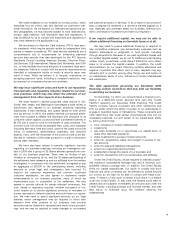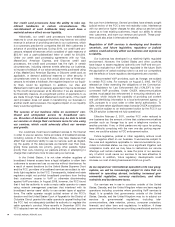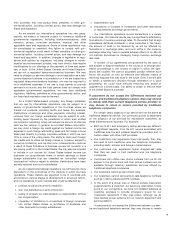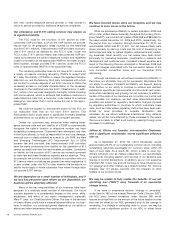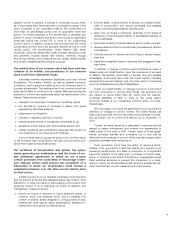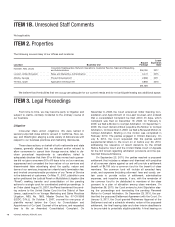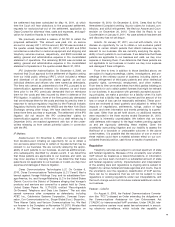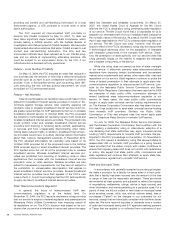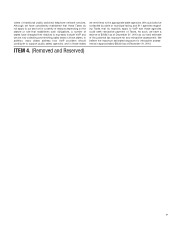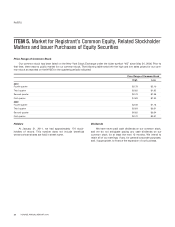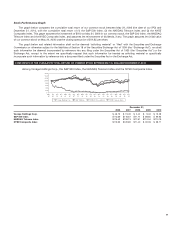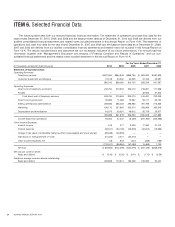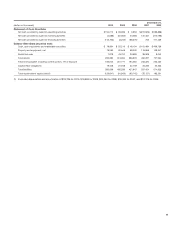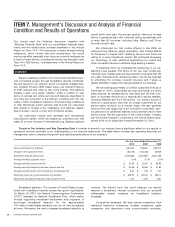Vonage 2010 Annual Report Download - page 23
Download and view the complete annual report
Please find page 23 of the 2010 Vonage annual report below. You can navigate through the pages in the report by either clicking on the pages listed below, or by using the keyword search tool below to find specific information within the annual report.w
i
t
h
t
h
e
i
r current te
l
ep
h
one serv
i
ce prov
id
er or ma
y
c
h
oose t
o
r
eturn to service provided b
y
traditional telephone companies
.
O
ur emergency and E-911 calling services may expose u
s
to signi
f
icant liability
.
T
he F
CC
rules for the provision of 911 service b
y
inter
-
connected VoIP
p
roviders, such as the VoIP service we
p
rovide
,
r
equire that for all
g
eo
g
raphic areas covered by the traditiona
l
wire line E-911 network, interconnected VoIP
p
roviders must
p
ro-
v
ide E-911 service as defined by the F
CC
’s rules. Under th
e
F
CC
’s rules, E-911 service means that interconnected VoIP
p
ro
-
v
iders must transmit the caller’s telephone number and re
g
istere
d
l
ocation information to the appropriate P
S
AP for the caller’s re
g
is
-
t
ered location. Vona
g
e provides E-911 service, under the F
CC
’
s
r
ules, to approximately 99.97
%
o
f
its subscriber lines
.
T
he remainin
g
subscriber lines do not have E-911 service
f
o
r
a variety of reasons includin
g
refusal by PSAPs to accept VoIP
911 calls, the inability of PSAPs to receive the registered location
data
f
rom us, and the
f
ailure b
y
third part
y
companies with who
m
we contract to provide aspects o
f
our E-911 service to obtain th
e
necessar
y
access or complete implementation o
f
the necessar
y
i
nter
f
aces to the traditional wire line E-911 in
f
rastructure. In addi-
t
ion, certain o
f
our services designed to be highly mobile including
s
o
f
t phone service, which is so
f
tware that enables a customer t
o
make telephone calls from a computer, route callers to a nationa
l
emergency ca
ll
center t
h
at
i
n turns routes t
h
eca
ll
to t
h
e appro
-
p
riate P
S
AP.
We could be subject to enforcement action b
y
the F
CC
for
ou
r
subsc
ri
be
r lin
es
th
a
t
do
n
o
th
a
v
e
E-
9
11
se
rvi
ce
. Thi
s
enforcement action could result in si
g
nificant monetary penaltie
s
and restrictions on our ability to offer non-compliant services.
Delays our customers may encounter when makin
g
emer-
g
ency services calls and any inability of a PSAP to automaticall
y
r
eco
g
nize the caller’s location or telephone number can have
devastatin
g
consequences. Customers have attempted, and may
i
n the
f
uture attempt, to hold us responsible
f
or any loss, dama
g
e,
p
ersonal injur
y
or death su
ff
ered as a result. In Jul
y
2008, the Ne
w
and Emerging Technologies 911 Improvement Act o
f
200
8
b
ecame
l
aw an
d
prov
id
e
d
t
h
at
i
nterconnecte
dV
o
IP
prov
id
er
s
have the same protections
f
rom liabilit
yf
or the operation o
f
91
1
s
erv
i
ce as tra
di
t
i
ona
l
w
i
re
li
ne an
d
w
i
re
l
ess prov
id
ers.
Li
m
i
tat
i
on
s
on liability
f
or the provision o
f
911 service are normally governed
by
state
l
aw an
d
t
h
ese
li
m
i
tat
i
ons t
y
p
i
ca
lly
are not a
b
so
l
ute.
Th
us
,
f
or example, we could be subject to liabilit
yf
or a problem with our
911 service where our
f
ailures are greater than mere negligence. I
t
i
s also unclear under the F
CC
’s rules whether the limitations o
n
li
a
bili
ty wou
ld
app
l
ytot
h
ose su
b
scr
ib
er
li
nes w
h
ere
V
onage
d
oes
not prov
id
e
E
-911 serv
i
ce
.
We are de
p
endent on a small number of individuals, and i
f
we
l
ose
k
ey personne
l
upon w
h
om we are
d
epen
d
ent, ou
r
business will be adversel
y
affected
.
M
an
y
of the ke
y
responsibilities of our business have bee
n
assigned to a relatively small number of individuals.
O
ur future
s
uccess
d
epen
d
s to a cons
id
era
bl
e
d
egree on t
h
ev
i
s
i
on, s
kill
s
,
experience, and effort of our senior management, especiall
y
M
arc P. Lefar
,
our
C
hief Executive
O
fficer. The loss of the service
s
of these officers could have a material adverse effect on our busi
-
ness.
I
na
ddi
t
i
on, our cont
i
nue
d
growt
hd
epen
d
s on our a
bili
ty t
o
attract an
d
reta
i
n exper
i
ence
dk
e
y
emp
l
o
y
ees
.
W
e
h
ave
i
ncurre
dl
osses s
i
nce our
i
ncept
i
on, an
d
we ma
y
co
ntin
ue
t
o
in
cu
rl
osses
in th
e
f
u
t
u
r
e
.
While we achieved profitabilit
y
in certain quarters in 2009 and
2010 under United
S
tates
G
enerally Accepted Accounting Princi-
p
les (“GAAP”), we incurred net losses of
$
42,598 and
$
83,665 for
th
e
y
ears en
d
e
dD
ecem
b
er 31, 2009 an
d
2010, respect
i
ve
ly
.
F
o
r
t
he period from our inception through December 31, 2010, ou
r
accumulated deficit was
$
1,171,901. Our net losses initiall
y
wer
e
driven primarily by start-up costs and the cost of developing our
t
ec
h
no
l
ogy an
dl
ater
b
y patent
li
t
i
gat
i
on sett
l
ements an
d
mar
k
et
-
i
ng expenses.
M
ost recent
l
y, our net
l
osses
h
ave
b
een
d
r
i
ven
p
r
i
nc
i
pa
ll
y
b
y mar
k
et
i
ng expenses,
i
nvestments
i
n researc
h
an
d
d
eve
l
opment an
d
customer care,
i
ncrease
di
nterest expense as
a
r
esult of the financing that we completed in November 2008 and
non-cash charges associated with the conversion feature of th
e
now converte
d
convert
ibl
e notes an
d
our
D
ecem
b
er 2010
r
efinancing.
Althou
g
h we believe we will achieve consistent pro
f
itability in
t
he
f
uture, we ultimately may not be success
f
ul. We believe tha
t
our ability to achieve consistent pro
f
itability will depend, amon
g
other
f
actors, on our ability to continue to achieve and maintain
s
ubstantive o
p
erational im
p
rovements and structural cost reduc
-
ti
ons w
hil
ema
i
nta
i
n
i
n
g
an
dg
row
i
n
g
our net revenues.
I
na
ddi
t
i
on,
ce
rt
a
in
of
th
e cos
t
sofou
r
bus
in
ess a
r
e
n
o
t within
ou
r
co
ntr
o
l
a
n
d
ma
yi
ncrease.
F
or examp
l
e, we an
d
ot
h
er te
l
ecommun
i
cat
i
ons
p
rov
id
ers are su
bj
ect to regu
l
atory term
i
nat
i
on c
h
arges
i
mpose
d
b
y regu
l
atory aut
h
or
i
t
i
es
i
n countr
i
es to w
hi
c
h
customers ma
ke
ca
ll
s, suc
h
as
I
n
di
aw
h
ere regu
l
atory aut
h
or
i
t
i
es
h
ave
b
een pet
i-
ti
one
dbyl
oca
l
prov
id
ers to cons
id
er term
i
nat
i
on rate
i
ncreases.
A
s we attract a
ddi
t
i
ona
li
nternat
i
ona
ll
ong
di
stance
callers, we will be more a
ff
ected b
y
these increases to the exten
t
t
hat we are unable to o
ff
set such costs by passing through pric
e
i
ncreases to customers
.
Jeffrey A.
C
itron, our founder, non-executive
C
hairman,
and a signi
f
icant stockholder, exerts signi
f
icant in
f
luenc
e
o
v
e
r
us.
As of December 31, 2010, Mr.
C
itron beneficiall
y
owne
d
approximately 26.0% of our outstanding common stock, including
outstanding securities exercisable for common stock within 6
0
days of such date. As a result, Mr.
C
itron is able to exert sig
-
nificant influence over all matters presented to our stockholder
s
for approval, including election and removal of our directors an
d
change of control transactions. In addition, as our non-executive
C
hairman
,
Mr.
C
itron has and will continue to have influence ove
r
our strategy and other matters as a board member. Mr.
C
itron’s
i
nterests ma
y
not alwa
y
s coincide with the interests of other
holders of our common stock.
We may be unable to
f
ully realize the bene
f
its o
f
our net
operatin
g
loss (“NOL”) carry forwards if an ownershi
p
c
h
ange occurs
.
I
f
we were to experience another “chan
g
e in ownership
”
under Section 382 of the Internal Revenue Code
(
“Section 382”
)
,
t
he NOL carry forward limitations under Section 382 would
i
m
p
ose an annual limit on the amount o
f
the
f
uture taxable incom
e
t
hat may be offset by our NOL
g
enerated prior to the chan
g
ei
n
ownership. I
f
a chan
g
e in ownership were to occur, we may b
e
unable to use a si
g
nificant portion of our NOL to offset futur
e
1
6
VO
NA
G
E ANN
U
AL REP
O
RT 2010


